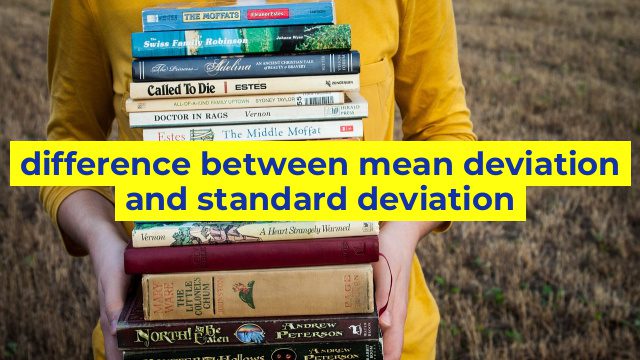The Difference between Mean Deviation and Standard Deviation
When it comes to analyzing data, two commonly used statistical measures are mean deviation and standard deviation. Although they are often used interchangeably, they are not the same. Understanding the difference between the two can help you make better decisions when interpreting data.
Mean Deviation
Mean deviation, also known as the average absolute deviation, is a measure of the variability of a dataset. It is calculated by finding the average distance between each data point and the mean of the dataset. Simply put, it measures how spread out the data is from the average.
While calculating the mean deviation is relatively straightforward, it is a less commonly used measure of variability, mainly because it is less sensitive to extreme scores in the data. As a result, it may not be as reliable in identifying outliers.
Standard Deviation
Standard deviation is another measure of variability in a dataset. It measures how much the data is spread out from the mean by calculating the square root of the variance. The variance is the average of the squared differences from the mean.
Standard deviation is a more widely used measure of variability because it provides a more accurate picture of the distribution of data. It is a powerful tool in identifying outliers and can help in understanding the degree of variability in the data.
So, What’s the Difference?
The key difference between mean deviation and standard deviation lies in their sensitivity to extreme values in the dataset. Mean deviation is less sensitive, while standard deviation is more sensitive.
In addition, standard deviation is a more accurate measure of variability, particularly for large datasets. It is widely used in statistical analysis, while mean deviation is used less frequently.
In conclusion, mean deviation and standard deviation are both useful measures of variability. However, they have different applications, and understanding their differences can help you choose the best measure for your data analysis needs. Remember, both measures have their strengths and weaknesses, and it is important to use them with care and to interpret their results in the appropriate context.
Table difference between mean deviation and standard deviation
| Measure | Mean deviation | Standard deviation |
|---|---|---|
| Definition | The average absolute deviation of each value from the mean of a data set | The square root of the variance of a data set |
| Formula | ∑|x-μ|/n |
sqrt(∑(x-μ)2/n) |
| Units | Same as the units of the data | Same as the units of the data, squared |
| Uses | Measures the average deviation of each data point from the mean | Measures the spread of data from the mean |
| Sensitivity to Outliers | Less sensitive to outliers than standard deviation | More sensitive to outliers than mean deviation |
